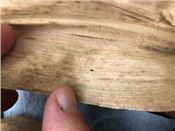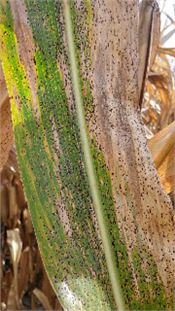Tar Spot Of Corn Confirmed In NE Missouri
LINDA GEIST
COLUMBIA, MISSOURI
University of Missouri’s Plant Diagnostic Clinic confirmed tar spot in three corn samples collected in the northeastern Missouri counties of Lewis and Holt on Aug. 30, according to Peng Tian, the clinic’s lab director.
Tar spot of corn is an emerging disease threat. In 2018, yield losses of 20-60 bushels per acre were reported during a severe outbreak in Indiana, says Mandy Bish, coordinator of the MU Integrated Pest Management program. Corn leaves can senesce prematurely when infected during critical grain fill stages.
Tar spot appears as circular or oval raised black dots (stromata) on both sides of leaves. A brown or tan halo may surround the spots, which can also appear on the sheaths and husks. Tar spot can appear on brown and green tissue, alone or in numbers.
“Insect frass, Physoderma brown spot and black micronutrient foliar fertilizers may be mistaken for tar spot,” says Bish. “Insect frass and foliar treatments can typically be scraped off the leaf surface with a fingernail. Physoderma brown spot has many small, brownish lesions on the leaf and dark lesions that are restricted to the midrib. Tar spot lesions will not be restricted to the midrib.”
Tar spot can also be confused with southern corn rust. Unlike the pustules of southern corn rust or common rust, the stromata of tar spot do not break through the leaf’s surface.
The fungal pathogen can infect multiple times in a single season. It overwinters on soil surface residues and spreads by wind and heavy rain. Prolonged periods of leaf wetness favor infection.
In 2019, the Plant Diagnostic Clinic confirmed tar spot in nine northeastern Missouri counties. Tar spot has spread through the Midwest, including Iowa, Illinois, Wisconsin, Ohio and Michigan.
This is the first confirmation of tar spot in Holt County. MU Extension agronomist Wayne Flanary has followed up on multiple reports from Holt County. “Tar spot is a new pest to this region of the state and obviously a concern for our producers,” he says.
If you suspect tar spot, submit samples to the diagnostic clinic for confirmation. Visit plantclinic.missouri.edu for instructions on submitting samples. You also may take photos of your plants and send them to plantclinic@missouri.edu. ∆
LINDA GEIST: University of Missouri

A single stroma of the tar spot pathogen on a brown senescing leaf. At low levels, tar spot can be difficult to detect, as it is only a single spot on a single leaf.
File photo by K. Bissonnette

Stromata of tar spot covering a leaf with both green tissue and brown senescing tissue. Multiple diseases can occur with tar spot. These black raised dots are the stromata of the tar spot pathogen, which overwinters on residues at the soil surface.
File photo by K. Wise